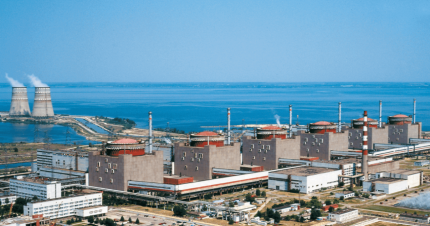
The International Atomic Energy Agency is continuing to monitor observance of the five concrete principles aimed at protecting Ukraine’s Zaporizhzhya Nuclear Power Plant (ZNPP) during the military conflict, where nuclear safety and security remain precarious, Director General Rafael Mariano Grossi said on 9 May in the IAEA’s Update 227. During the week of 1-8 May, the IAEA team stationed at the ZNPP have heard military activities on most days, including artillery and rocket fire some distance away from the plant, as well as small arms fire both near to and further away from the site.
On 8 May IAEA experts on site reported that there was an air raid alarm with restrictions on movement outside of buildings for about 90 minutes, which the ZNPP informed the team was allegedly due to drones being present in the area of the cooling pond. The experts did not hear any explosion during the period of the restriction on movement. Earlier on 8 May however another air raid alarm was heard, again restricting outside movement and resulting in the team’s planned walkdown within the site.
The persistent dangers facing Europe’s largest nuclear power plant (NPP) were underlined early in April, when the site was targeted in several drone strikes. The IAEA is also aware of reports alleging that a training base for drone operators as well as drone launch pads have been deployed near the ZNPP’s reactor unit 6 and its training centre. The IAEA experts have not seen any evidence of drones being launched, or the presence of training facilities or launching pads, within the site perimeter, but have requested access to the rooftop of a nearby laboratory building. The ZNPP has informed the IAEA team that the request is under consideration.
Staffing at ZNPP
Regarding the staffing situation at the plant, ZNPP has informed the IAEA team that it currently has about 5000 staff, which represents an increase from last year, but still significantly fewer than it had before the conflict.
ZNPP has informed the IAEA that that nominal staffing levels for nuclear power plants operated by Rosatom are significantly lower than the corresponding staffing levels of Ukraine. The plant said it was continuing to hire personnel and currently has 800 open positions. Nevertheless, the ZNPP said that it has recruited enough qualified staff, including the required number of authorised operators for the main control rooms, for the current shutdown status of the units.
However, as IAEA experts continue to be prevented from freely talking to main control room staff, affecting the Agency’s ability to independently assess the knowledge and experience of these personnel that are essential to maintaining nuclear safety at the ZNPP.
Elsewhere in Ukraine, the IAEA teams at the Khmelnytskyy, Rivne, and South Ukraine NPPs as well as at the Chornobyl site reported that nuclear safety and security continues to be maintained.
Ukraine’s air defences are under strain
Ukrainian air defences have been intercepting most Russian missiles, but in recent months more and more have made it through, crippling Ukraine’s ability to protect major infrastructure and plunging cities into darkness.
A New York Times analysis of daily Ukrainian military reports shows a major shift. Kyiv reported intercepting more than 80 % of the missiles last May. That rate has now dropped to less than half, as Ukraine calls for more supplies and Russia fires larger barrages that overwhelm Ukrainian air defences and faster missiles that are harder to shoot down.




